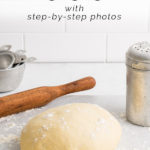Homemade Pizza Dough

- Resting Time: 1-2 hours
- Prep Time: 15 mins
- Cook Time: 30 mins
- Total Time: 45 minutes
- Yield: Serves 2 to 4
- Category: Bread
- Method: Oven
- Cuisine: Italian
Make your own pizza at home with this easy and delicious pizza dough recipe! Recipe with step-by-step photos.
Ingredients
- 250 g (1 2/3 cup) strong white bread flour
- 1 teaspoon instant yeast
- 1/2 teaspoon fine salt
- 2 teaspoons caster sugar
- 150 ml (1/2 cup plus 1 tablespoon) warm water
- 2 tablespoons extra virgin olive oil
- 2 tablespoons extra virgin olive oil, for proofing the dough
Instructions
To make the pizza dough
- Place the flour, instant yeast, salt and sugar into a large mixing bowl. I use an electric stand mixer to make bread, but you can also make the bread by hand.
- Measure the water into a measuring jug, and add the olive oil.
- Lightly mix together the dry ingredients.
- Slowly add the liquid ingredients until the mixture comes together into a dough. You may not need all of the liquid, or you may need to add a bit extra.
- Knead the dough for about 15 to 20 minutes. I generally do this on medium speed with the stand mixer.
- The dough should be ready when it is smooth and elastic in texture.
- Place 1-2 tablespoons of olive oil into a clean, large mixing bowl.
- Place the dough into the bowl and turn it so that it is completely covered in the oil.
- Cover the bowl with a clean tea towel, and place the bowl somewhere warm for the dough to double in size. This should take 1 to 2 hours. (See Kitchen Notes below)
- Once the dough has doubled in size, punch it back to knock out the air.
- Knead the dough gently (just a few turns) until it soft and smooth again.
To prepare the pizza
- Preheat the oven to 220°C/430°F.
- Place a large metal baking tray to preheat in the middle of the oven. If you are using a special pizza tray, pizza stone or cast-iron pan, also place this into the cold oven to preheat.
- Transfer the dough onto a sheet of baking paper.
- Gently stretch the dough into your desired shape, and which will fit your pizza tray or cast-iron pan.
- Stretch the dough by pushing from the centre outwards, creating a thick crust as you do so. As you stretch the dough, it may shrink back a little. Let the dough shrink or relax after each stretch, before you continue stretching to your desired shape. The dough will rise a little upon baking, so keep the thickness of the dough in mind.
- Spread the dough with the sauce of your choice, leaving a small border.
- Add some freshly grated mozzarella and the toppings of your choice.
To cook the pizza
- When you are ready to bake, transfer the pizza – together with the baking paper – onto the pizza tray or cast-iron pan. Be careful – the pizza tray or cast-iron pan will be very hot!
- Trim off any excess baking paper, otherwise it might catch in the oven.
- Bake the pizza for 15-20 minutes, or until the cheese has fully melted and the edges of the pizza are lightly golden.
- Serve immediately.
Kitchen Notes
 MINI PIZZAS OR KIDS PIZZA
MINI PIZZAS OR KIDS PIZZA
This recipe makes enough pizza dough to divide into 2 portions for 2 small pizzas.
 MAKING MULTIPLE PIZZAS
MAKING MULTIPLE PIZZAS
If you plan to multiply the recipe to make more pizzas, I recommend proofing the dough separately (and not as one large piece of dough). This will allow the dough to trap more carbon dioxide as it is proofing, which will result in a lighter dough.
 TYPES OF FLOUR
TYPES OF FLOUR
For Swiss readers: I use Zopfmehl (or farine pour tresse) when making bread and enriched dough.
 DIFFERENT TYPES OF YEAST
DIFFERENT TYPES OF YEAST
* Please note that there is a difference between instant yeast (also called instant dried yeast or fast-action dried yeast) and dried yeast (also called active dry yeast). If you are not sure what type of yeast you have, please check the packaging for instructions on how to use the yeast.
* With instant yeast, you can add it directly to the flour mixture without having to activate it first.
* With dried yeast, you will need to activate it first (usually in some warm liquid).
 PROOFING THE DOUGH
PROOFING THE DOUGH
Dough needs a warm environment for the yeast to activate and cause the dough to rise. If you don’t have a warm place in your home, try one of the following ideas:
* In the oven with the oven light switched on (works only for some ovens).
* In the oven with a tray of boiling water on the bottom shelf.
* In the oven at a low temperature of about 25-30°C (77-86°F).
 OVEN TEMPERATURES
OVEN TEMPERATURES
All recipes on this website state temperatures for a regular oven (i.e. a conventional oven without fan). If you have a convection oven with a fan, please consult the manufacturer’s handbook on how to adjust the temperature and baking time accordingly.
 CONVERSIONS
CONVERSIONS
To convert from cups to grams, and vice-versa, please see this handy Conversion Chart for Basic Ingredients.
View the recipe online: https://eatlittlebird.com/homemade-pizza-dough/

